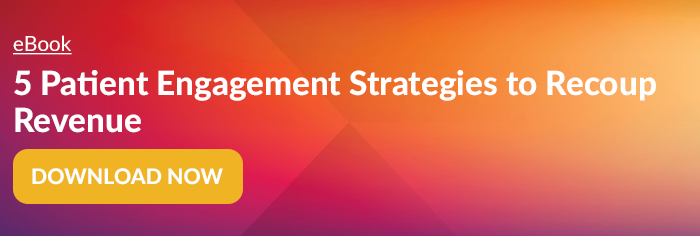In the spring of 2020, healthcare use and spending dropped quickly due to cancellations of elective care to increase hospital capacity and canceled appointments to implement social distancing measures. In fact, 28 percent of hospital systems had a negative operative margin as of September 2020. Although healthcare use increased toward the end of 2020, it was not enough to compensate for the missed care earlier in the year.
There's no doubt that the financial losses from the COVID-19 pandemic will have lasting effects on health systems; however, now is the time to focus on strengthening your patient engagement strategies to help attract and retain more patients. Here are five patient engagement strategies that can help your health system recover lost revenue.
Continue to Utilize Virtual Visits
Virtual visits can improve the patient experience and the appointment follow-up process. But it's important to consider a balance of virtual and in-person care. According to our recent Patient Engagement Survey, the top three specialties that survey respondents prefer to see via telehealth are primary care, mental health, and dermatology, while patients preferred in-person visits for more specialized medical care such as urology, ENT (ear, nose, and throat), and pulmonology appointments. Health systems need to be cautious about a one-size-fits-all approach that could result in a poor patient experience. Identify the patients and populations that are the right fit for virtual visits based on their condition and consider offering telehealth as an option for patients who prefer a virtual visit.
Provide Post-Discharge Follow-Up & Scheduling
Scheduling an appointment for patients' follow-up visits before they leave your facility can help ensure patients don't forget to make—or worse yet, miss—their follow-up appointment. Post-discharge follow-up keeps patients in your health system's revenue pipeline and simultaneously reduces the likelihood that they are readmitted to your facility. Personalized follow-up can be successfully implemented using automated messaging via email, text, and pre-recorded messages based on patient profiles. You should also consider a system that routes and escalates calls based on patient responses to customized prompts, which can drive improved patient outcomes and help prevent readmission.
One study found that no-shows cost the U.S. healthcare system more that $15B a year and individual physicians an average of $200 per unused time slot.
Reduce No-Shows with Text Reminders
Missed appointments are costly—to health systems and patients. For health systems, no-shows waste the time and expertise of providers and result in lost revenue. For patients, missed appointments can be detrimental to their health. Appointment reminders reduce the likelihood that the patient cancels or doesn't show up. And if your health system uses a waitlist for cancellations, text messages give you an automated ability to fill the spot if someone replies "No" to their appointment confirmation message.
Close the Referral Loop
One of a health system's largest sources of revenue is through patient referrals from specialty clinics and physician groups. Ensuring that providers refer patients to specialists within the health system is an important revenue opportunity—as is following-up on those referrals. Lack of referral follow-through means patients may not get seen or go to another provider. Successfully stopping leaks is a matter of consistently closing the referral loop. Automated referral reminders with links to schedule appointments as well as live voice services can coordinate care for patients, retain them within your health system, and drive referral adherence.
The cost of referral leakage for U.S. health systems is estimated at $78-$97 million of annual revenues for every 100 affiliated providers, and most health systems lose an average of $200-$500 million per year to competitors.
Capitalize on Vaccine Patients
The COVID-19 vaccine is providing a steady flow of patients for health systems. As vaccine patients enter your health system, be sure to engage in post-vaccine follow-up—offering follow-up care and instructions, scheduling for future doses, and vaccination reminders. At the same time, systemically and consistently check to see if patients have a primary care provider. If they don't, now is the time to follow-up by email and phone and gain their commitment to a broader range of care within your health system. Being the provider that successfully administers the vaccine has a strong emotional appeal, and patients may be more open to forming a new relationship or becoming more loyal as a result.
Navigating the COVID-19 pandemic has been challenging for health systems. Revisiting and strengthening patient engagement strategies can help keep patients engaged and loyal to your health system, which in turn helps your bottom line. To learn more about these patient engagement strategies, download our eBook: 5 Patient Engagement Strategies to Recoup Revenue.

